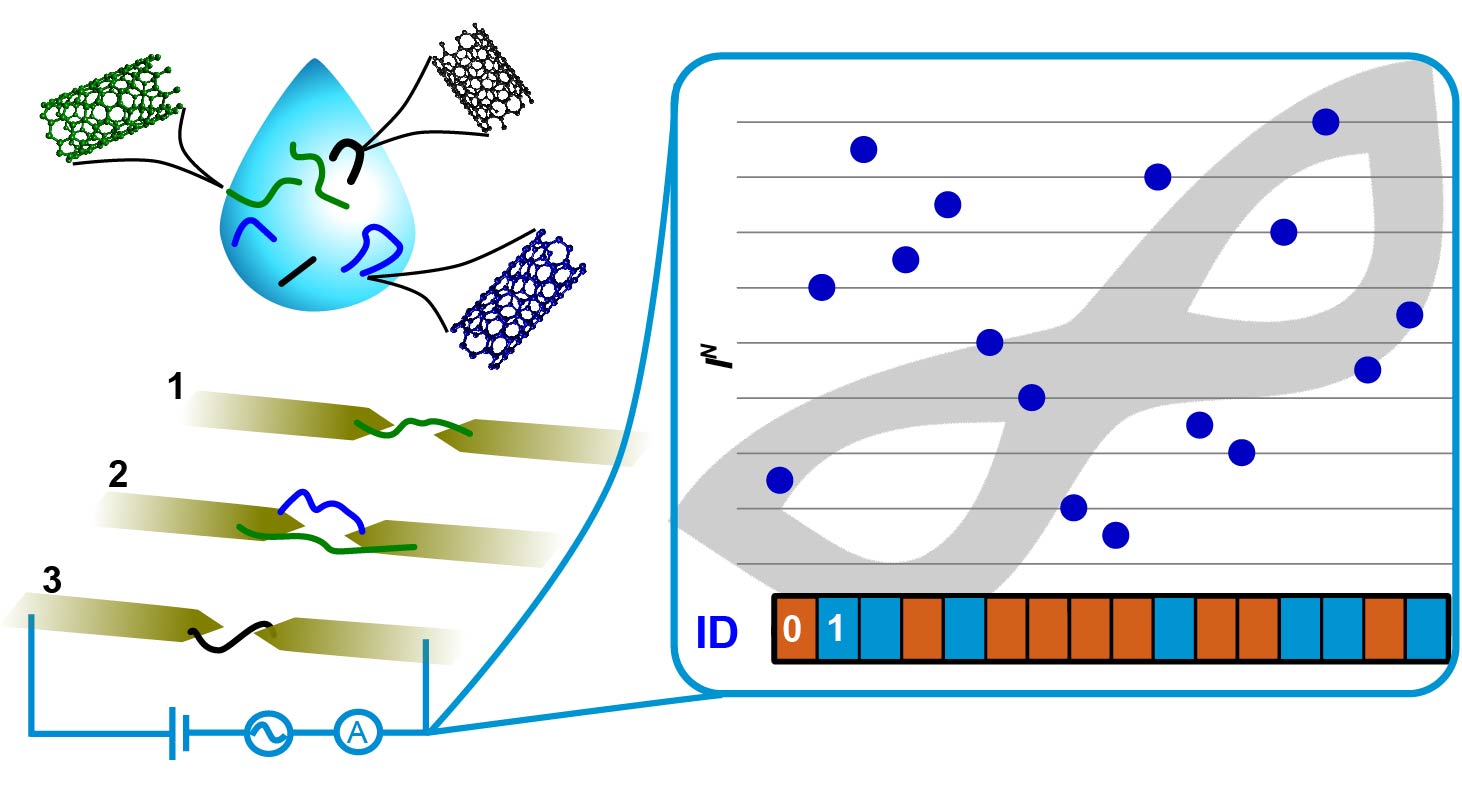Fighting counterfeit with carbon nanotubes
20.05.2019
 |
|
Physically unclonable functions based on single-walled carbon nanotubes. Image: Enrique Burzurí. |
Researchers at IMDEA Nanociencia have developed a physically unclonable function based on carbon nanotubes with potential applications in security and anti-counterfeiting.
The ubiquity of electronic devices makes it essential to use encryption and anti-counterfeiting tools to protect the privacy and security of users. With the growing expansion of the Internet of Things, protection against attacks that violate the authenticity of products is increasingly necessary. Traditionally, message protection has been based on different systems: passwords, digital signatures or encryption. This cryptography is based on unknown keys to a possible attacker, but unfortunately these systems are becoming obsolete as new more invasive attacks appear: malware, API attacks or physical hardware attacks.
While quantum computing slowly progresses towards the cryptographic paradigm, the so-called physically unclonable functions (PUFs) are presented as the choice to ensure unique and effective identification. A PUF is a device that has unique and non-repeatable physical properties that can be translated into usable bits of information. The idea of applying random physical characteristics to identify systems or people is not new: for example, the identification of individuals using the fingerprint dates from the 19th century. More recently, the identity of electronic devices has been established using PUFs, which are "electronic fingerprints" of an integrated circuit.
Authentication based on PUFs comprises a chip manufactured by intrinsically random processes that make cloning almost impossible, even though all the details of the manufacturing process are known. The measurements of the various physical properties of the PUF depend on the properties of the chip at the nanoscale, thus constitute a very powerful anti-fraud and anti-counterfeiting technology. To be implementable at an industrial level, this chip must be low cost, scalable and its properties must be easily measurable by means of an identifiable function.
Enrique Burzurí, Daniel Granados and Emilio M. Pérez (researchers at IMDEA Nanociencia) have proposed an ingenious and simple PUF based on carbon nanotubes. The carbon nanotubes are assembled by dielectrophoresis to a series of 16 electrodes forming random junctions: in each pair of electrodes there are one, several or no nanotubes. The measurement of the intensity-voltage curves provides a unique pattern that is inherent to each PUF and is almost impossible to reproduce. This nanotechnology exploits a characteristic of carbon nanotubes that has usually been detrimental: the difficulty of obtaining carbon nanotubes with identical chirality, that is, with identical electronic properties (conductor or semiconductor). Also, the inherent manufacturing defects such as vacancies or oxygen functionalities mean that two carbon nanotubes with the same chirality do not have the same conductance. These disadvantages have been transformed into the PUF strongest point.
These PUFs conceived at IMDEA Nanociencia are easily measurable physical devices that provide a pattern of intrinsic conductance to each of them that is extraordinarily difficult to duplicate. Given the same PUF two different inputs produce different responses, and given the same input two PUFs produce two different responses. In this way, these PUFs based on carbon nanotubes can be identified by the value of the responses they generate to specific inputs. Any PUF defect is not valid here; it must be measurable and provide a unique signature. Currently there are several types of PUFs that are based on physical properties such as reflectivity or magnetic anisotropy. However, the current measurement proposed by Burzurí et al. it is the simplest, cheapest (1 step of lithography) and the most easily implantable in an electronic circuit, besides being potentially scalable to a greater number of electrodes to increase its complexity. These PUFs could be implemented in smartphones, microcontrollers, smart sensors, actuators and could also be used as a digital signature.
This research is the result of the collaboration between three IMDEA Nanociencia researchers: Enrique Burzurí, Daniel Granados and Emilio M. Pérez. The study has been co-funded by the European Commission (MSCA-IF and ERC), the Spanish Ministry of Economy and Competitiveness and the Regional Government of Comunidad de Madrid, as well as the national Severo Ochoa Programme for Centers of Excellence.
Reference:
E. Burzurí, D. Granados and E. M. Pérez. Physically unclonable functions based on single-walled carbon nanotubes: a scalable and inexpensive method toward unique identifiers. ACS Appl. Nano Mater. 2019.
Contact
Enrique Burzurí
This email address is being protected from spambots. You need JavaScript enabled to view it.
http://nanociencia.imdea.org/functional-nanoscale-materials-and-devices/home
Twitter: @enburz
IMDEA Nanociencia Outreach Office
This email address is being protected from spambots. You need JavaScript enabled to view it.
+34 91 299 87 12
Twitter: @imdea_nano
Facebook: @imdeananociencia
Source: IMDEA Nanociencia




